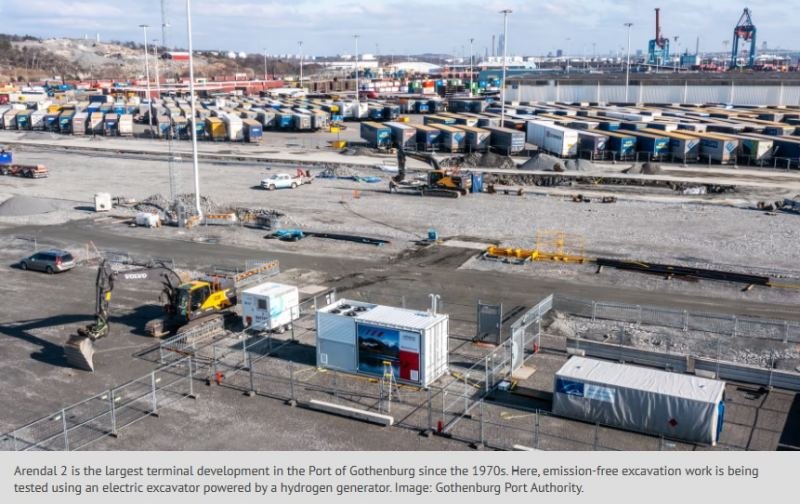In a significant step towards sustainable infrastructure development, the Port of Gothenburg has initiated a collaboration with Hitachi Energy and Skanska, showcasing pioneering technology in emission-free excavation work. This groundbreaking venture marks a milestone in the port’s ambitious efforts to reduce carbon emissions and embrace innovative solutions for a greener future.
At the heart of this collaboration lies a hydrogen generator featuring cutting-edge technology, which has been deployed for excavation work in one of the largest infrastructure projects ever undertaken by the Port of Gothenburg. This portable and scalable generator represents a revolutionary approach to sustainable energy solutions, incorporating fuel cell modules, power electronics, cooling systems, and an intelligent control system.
Hitachi Energy, in collaboration with its technology partner PowerCell Group, has spearheaded the development of this hydrogen generator, which is being piloted for the first time at the Port of Gothenburg’s new terminal area, Arendal 2. Over the past two weeks, the generator has been utilizing green hydrogen provided by Linde Gas to power a charging station on-site. Subsequently, this station supplies electricity to an electric excavator from Volvo, facilitating emission-free excavation work in the ongoing infrastructure project.
Arendal 2 represents a significant endeavor for the Port of Gothenburg, symbolizing a commitment to innovation and sustainability in port development. The project, which commenced in 2016, incorporates advanced techniques such as stabilization and solidification of contaminated dredged material, underscoring the port’s dedication to environmental stewardship.
David Norén, project manager for Arendal 2 at the Gothenburg Port Authority, expressed enthusiasm about the collaboration, emphasizing its alignment with the port’s values of collaboration, sustainability, and innovation. He highlighted the significance of integrating such innovative solutions into the project, heralding a new era of sustainable port operations.
The adoption of hydrogen technology holds immense potential for reducing carbon emissions across various facets of port operations, as Viktor Allgurén, innovation manager at the Gothenburg Port Authority, explains. From fueling trucks and handling equipment to powering ships and supporting the grid during shore connections, hydrogen offers a versatile and eco-friendly solution tailored to the unique demands of port environments.
The Port of Gothenburg’s collaboration with Hitachi Energy and Skanska exemplifies a proactive approach to sustainable development, aligning with the port’s overarching goal of reducing CO2e emissions by 70 percent. This initiative underscores the port’s pivotal role as a leader in fostering climate-efficient freight transport and advancing sustainable practices within the maritime industry.
About Port of Gothenburg
The Port of Gothenburg stands as the largest port in Scandinavia, facilitating a significant portion of Swedish domestic and foreign trade. With a steadfast commitment to sustainability, innovation, and digitalization, the port offers industry-leading access to global markets while prioritizing environmental conservation and efficiency in freight transport. Employing over 22,000 individuals, the port serves as a vital hub for energy products, vehicles, containers, and passengers, embodying a vision of sustainable development for the future.
Source Port of Gothenburg

